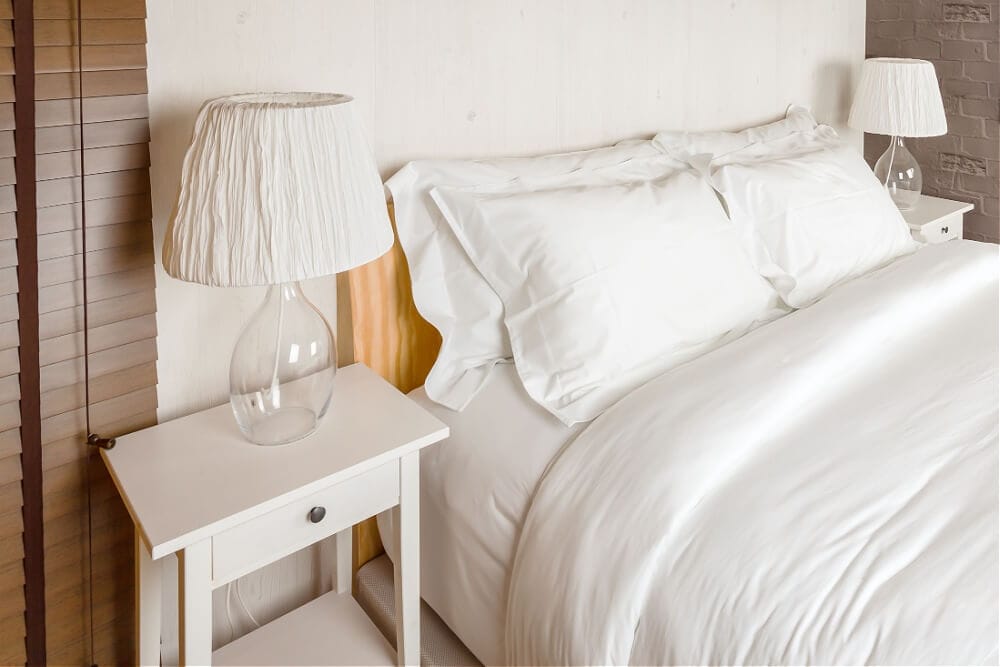There’s something so refreshing about crisp, white sheets. They add a touch of luxury to any bedroom!
But when the white fabric starts to turn grey or yellow, restoring the sheets to their pristine state can be tricky.
Bleach might seem like the easy fix, but harsh cleaners should be your last resort.
Instead, try milder options like white vinegar, baking soda, and lemon juice.
Before Whitening | Pre-Treating Stains | Pre-Soaking | Washing | Drying | Care Tips
What Causes Yellowing and Stains on White Sheets?
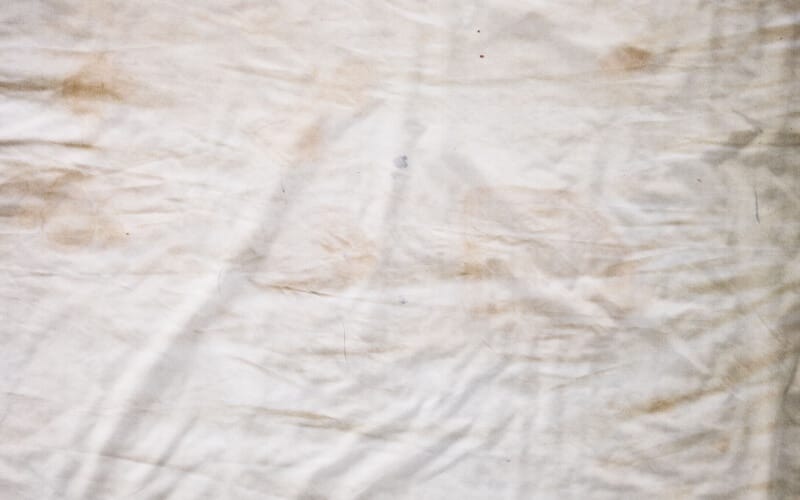
White bed linens can turn yellow over time due to a build-up of body oils, saliva, and sweat.
These substances react with oxygen in the air (aka oxidation), creating yellowish spots on white sheets.
Any creams and lotions you use are also another cause.
They may contain oils that can stick to the fabric and leave a yellowish residue.
Other things that can dull the brightness of white sheets include:
- Hard water
- Fabric softeners
- Inadequate rinsing
- Infrequent washing
White linens can also pick up stains from food or drink spills, fake tan, and makeup.
Before Whitening Sheets
Before getting started, check the care label on your sheets first.
Some delicate fabrics need cold water while others can handle warmer temps.
Follow any instructions to keep your white sheets in top shape.
Then, pre-treat stains and make sure they’re completely gone before washing the sheets.
Heat from the washer or dryer can make the stains on your white bedding permanent!
Test brighteners and stain removers on a hidden spot first — especially for delicate sheets like bamboo and silk.
While you don’t have to worry about fading white sheets, harsh cleaners can sometimes damage the fabric.
It’s also important to sort your laundry.
Wash white sheets separately or only with other white items to avoid colour transfer.
Pre-Treating Stains on White Bed Sheets
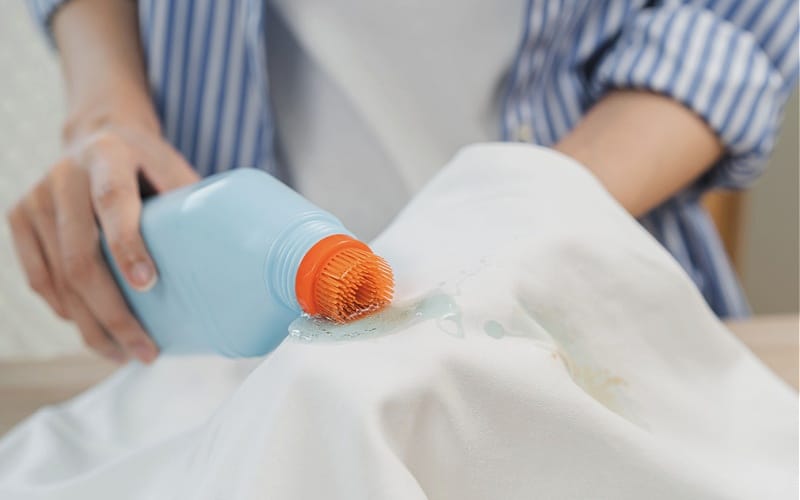
Tackle stains on your white sheets immediately. Leaving them on for too long can cause stains to set.
BLOOD STAINS: Flush with cold water, then spray 3% hydrogen peroxide onto the stain. Let it sit for 10–15 minutes.
FOOD OR DRINK STAINS: Remove any solid food bits, then rinse with cold water. Apply a thick baking soda paste, and let it work for 15–30 minutes.
MAKEUP STAINS: Rinse the stain with cold water. Then, apply dish soap to the stain. Let it sit for 15–30 minutes.
SWEAT STAINS: Mix 1 tbsp oxygen bleach per litre of lukewarm water. Soak the stained area in the solution for 15–30 minutes.
URINE STAINS: Apply an enzyme cleaner as directed. Remove any lingering pee odour by adding 1 cup of white vinegar to the rinse cycle.
After applying the treatment, gently rub the fabric against itself to loosen the stain further.
Then, rinse the sheet thoroughly to remove any residue from the cleaning product.
If the stain persists, repeat the process until your white sheets are spotless!
How to Whiten Sheets by Pre-Soaking
Now, how to whiten sheets? If your sheets are heavily yellowed, pre-soaking before washing is the most effective way!
It allows cleaning agents to penetrate the fabric and break down set-in stains.
Start by filling a tub or a large basin with water. Use cold or warm water, based on the care label.
Add any of the whitening treatments listed below — arranged from mildest to strongest.
Soak the sheets in the solution for at least 1 hour, or overnight for tough stains.
Afterwards, wash your sheets as usual.
NOTE: These methods are suitable for most bed sheets. But for delicate sheets like satin and silk, vinegar is the safest option.
Always spot-test first to be sure!
Option 1: White vinegar
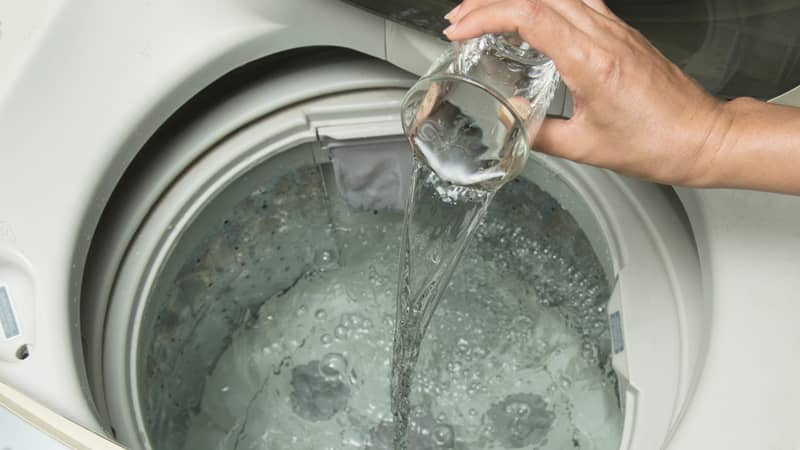
HOW TO USE: Add half a cup of vinegar per 4L of water.
White vinegar is a gentle, eco-friendly way to whiten yellowed sheets.
Its acidity helps break down hard water deposits and detergent residue, leaving your sheets soft and bright.
Option 2: Baking soda
HOW TO USE: Add half a cup of baking soda per 4L of water.
Baking soda (or bicarb soda) is another household staple that can whiten sheets.
Its alkaline and mildly abrasive properties help lift surface stains from sheets.
Beyond stain removal, baking soda can also remove bad smells from sheets.
Option 3: Lemon juice
HOW TO USE: Mix half a cup of lemon juice per 4L of water.
Lemon juice is an excellent method to whiten sheets without bleach.
It contains citric acid, which acts as a mild bleaching agent. It also leaves a subtle citrusy scent on fabrics!
For a more convenient option that doesn’t require squeezing lemons, you can use citric acid powder.
Dissolve ¼ cup of citric acid powder per 4L of water to achieve the same brightening effect.
Option 4: Borax
HOW TO USE: Add half a cup of borax per 4L of water.
You can use borax to whiten sheets!
Borax is a natural mineral with many uses — from killing mould to whitening fabrics.
When borax is added to water, it produces hydrogen peroxide, which helps lift stains and discolouration.
Option 5: Hydrogen peroxide
HOW TO USE: Mix 1 part hydrogen peroxide with 3 parts water.
Hydrogen peroxide is an effective way to get yellowed sheets white again!
As it breaks down, it releases oxygen, which helps loosen and lift stains.
A 3% hydrogen peroxide solution is generally safe for whitening most types of sheets.
Avoid using stronger concentrations, as these can damage fabrics.
Option 6: Oxygen bleach
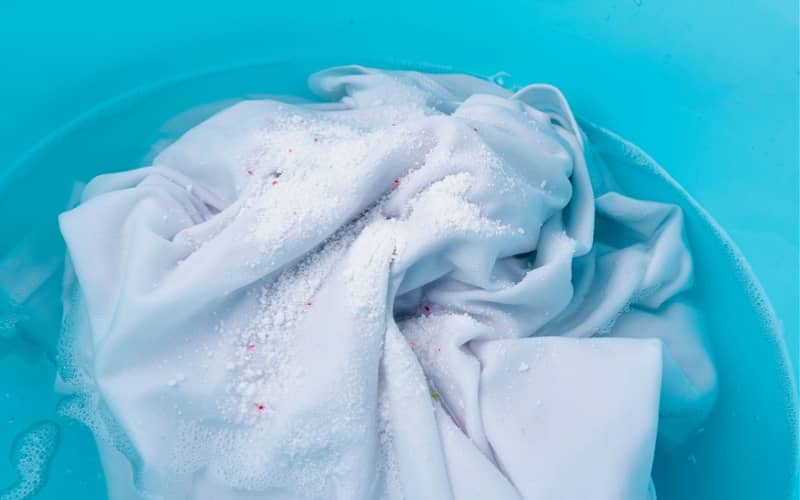
HOW TO USE: Dissolve oxygen bleach in water, following the dilution instructions on the label.
Oxygen bleach is a powerful yet gentle treatment that can get sheets white again.
Unlike chlorine bleach (which uses sodium hypochlorite), oxygen bleach relies on oxygen-based cleaners.
These include hydrogen peroxide, sodium perborate, and sodium percarbonate.
These compounds release oxygen in the water, which breaks down stains without damaging fabrics.
Whitening Sheets in the Wash
For mild yellowing, you can skip the pre-soak and whiten sheets directly in the wash cycle.
You can also follow these same steps to prevent white sheets from yellowing.
For this method, use a high-efficiency liquid detergent — it’s concentrated and rinses out easily.
Follow the care label on the sheets for the correct water temp to use.
For extra brightening, add one of these cleaning agents to the wash cycle along with the laundry detergent:
- Half a cup of borax
- Half a cup of baking soda
- 1 cup of 3% hydrogen peroxide
- Oxygen bleach (per label instructions)
- Juice from one lemon (or ⅓ cup of citric acid powder)
Another option is to add half a cup of vinegar to the final rinse cycle.
However, keep in mind that you should use one treatment at a time. Mixing cleaning agents can be harmful!
After washing, run an extra rinse cycle without detergent to eliminate any residue from cleaning products.
How to Dry White Sheets
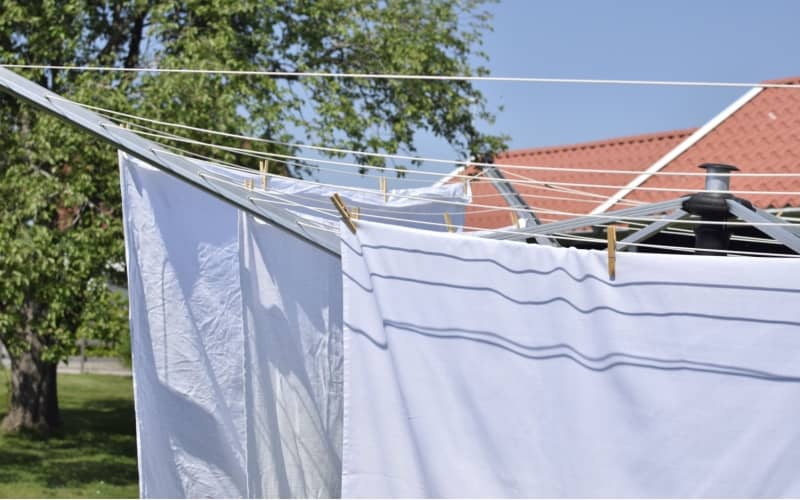
For extra brightening, hang white sheets on a line under direct sunlight.
The sun’s ultraviolet rays can naturally brighten fabrics.
For faster drying, you can tumble dry most sheets except for satin and silk.
Use the lowest heat setting and run a 10-minute cycle.
Remove the sheets while they’re still damp, then finish by air drying them out in the sun.
How to Maintain White Sheets
To keep bed linens white, wash them weekly. This prevents body oils and dirt from building up.
If you need some extra help around the house, cleaning experts can assist with laundry and general upkeep.
For those in hard water areas, use a water softener to prevent mineral deposits from accumulating on your sheets.
It’s also important to avoid dryer sheets and fabric softeners.
These products may leave behind stubborn residue that can dull or stain white sheets.
Finally, fold the sheets properly and store them in a cool, dry place.
FAQs on Whitening Sheets

Learn more about how to revive yellowing white sheets!
Can you use bleach to whiten sheets?
Chlorine bleach can whiten sheets, but use it with caution.
It’s best saved for emergencies or when gentler methods — like hydrogen peroxide and oxygen bleach — haven’t worked.
When using bleach to whiten sheets, always dilute it according to the label instructions to avoid damage.
Using too much or undiluted bleach can cause yellow stains on white sheets.
It can also make cotton sheets lose their softness and deform natural fibres like bamboo, linen, and silk.
Is bleach or vinegar better for white sheets?
Bleach is better for heavy, stubborn yellowing. However, it should not be used on delicate fabrics.
Meanwhile, vinegar is gentle enough for delicate sheets.
You can also use it for regular washes to prevent white sheets from yellowing.
How to whiten delicate sheets?
White vinegar is the best choice for whitening delicate sheets like bamboo, satin, and silk.
Fill a large basin or a tub with cold water. For every 4L water, add half a cup of vinegar.
Pre-soak the sheets in this solution for 30 minutes, then wash as usual.
Afterwards, air-dry the sheets in a shaded area.
When they’re nearly dry, hang the sheets under direct sunlight for 10–15 minutes.
Don’t leave them out too long, as too much heat can shrink delicate fabrics!
Can you combine baking soda and vinegar to whiten sheets?
We do not recommend combining the two! Vinegar is acidic, and baking soda is alkaline.
When mixed, they neutralise each other, which reduces their cleaning ability.
To whiten sheets, use them separately.
For example, you can use baking soda as a pre-soak treatment and vinegar in the rinse cycle.
Can liquid bluing whiten sheets?
Yes, liquid bluing can brighten yellowing sheets.
However, keep in mind that liquid bluing is an optical whitener — not a stain remover.
It adds a subtle blue tint to counteract yellow hues, making bed sheets look whiter.
However, it’s not a permanent fix, as the blue tint can fade with repeated washes. In this case, you’ll need to reapply liquid bluing to maintain the whitening effect.
To use liquid bluing, dilute it in cold water first. Strictly follow the dilution instructions on the label.
Using liquid bluing incorrectly can leave blue patches on your sheets!
Add the solution to the wash or final rinse cycle.
Never pour liquid bluing directly onto fabric, and do not use it with bleach or fabric softeners.
How do hotels keep their sheets so white?
To keep bed sheets white, hotels use a combination of powerful detergents, bleach or oxygen-based cleaners, and hot water washes.

